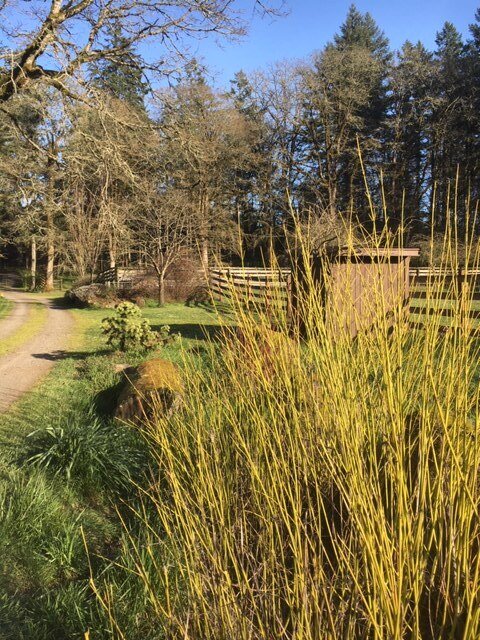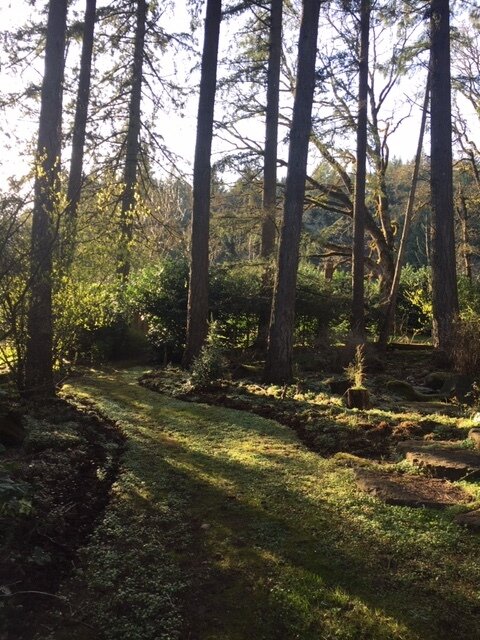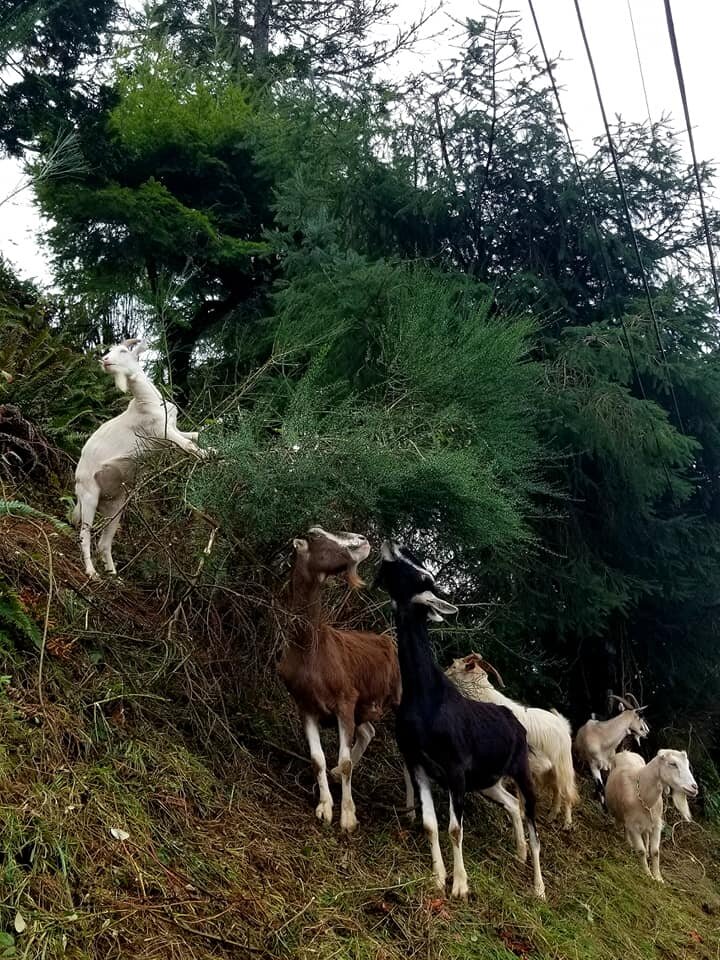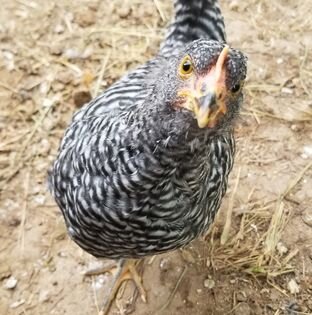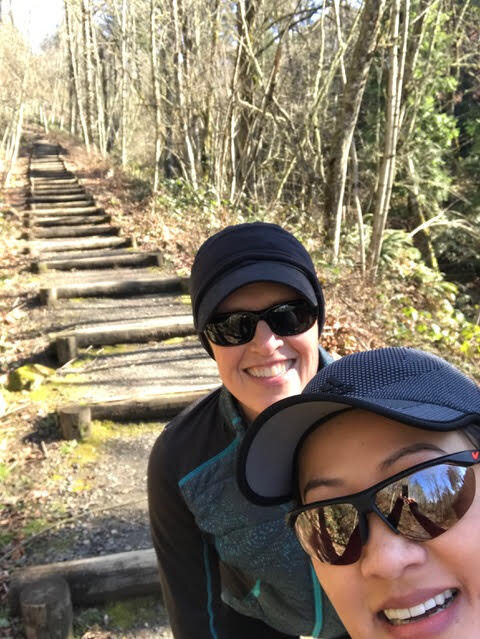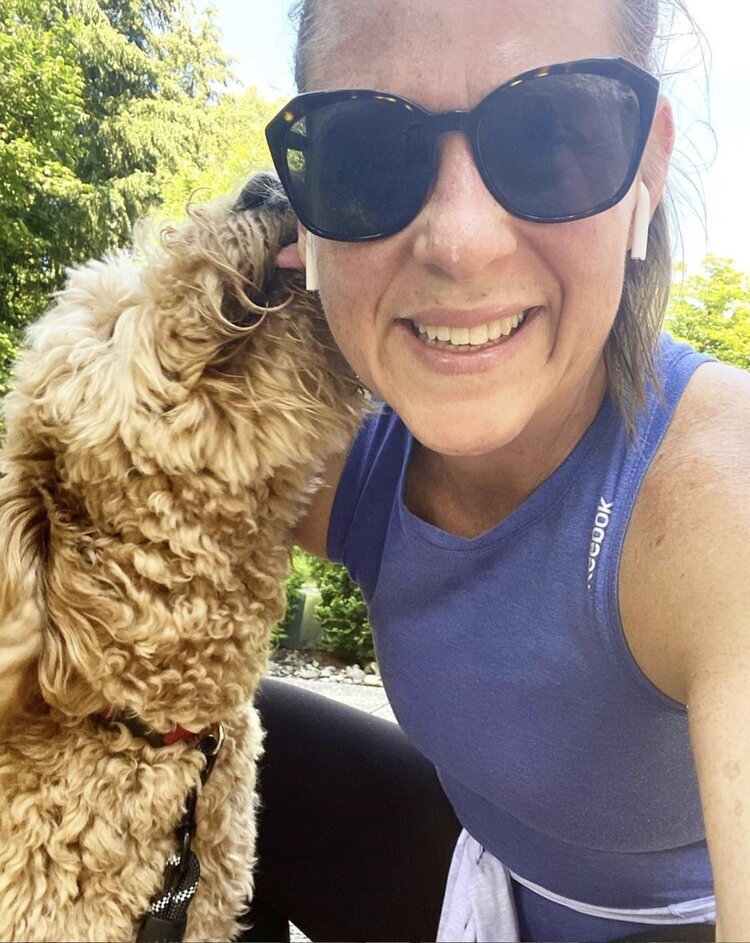“Dear Nature.” That’s how students are asked to begin their reflection piece, by writing a letter with nature as their audience. This terrific idea didn’t just sprout out of nowhere. It is among the many brainchildren of Sarah Woods and Bethany Thomas, co-founders of Ecology in Classrooms and Outdoors (ECO). ECO inspires students to care for nature and their local communities through hands-on science education.
A Different Harvest
This August, in the loneliness of quarantine, I sold the farm in Yamhill County where I had lived for almost thirty years and moved into the city. The fruit trees my toddlers helped me plant were in the bountiful glory of their maturity. Livestock sheds, pasture rotations, and manure management had all been honed to clockwork function. Planning and labor and more than two decades of growth had brought the farm and me to the time of harvest, but instead of pressing cider and filling the basement pantry with jams and pickles, I filled two dumpsters with the odds and ends a farm and family collects.
I had thought I would always live there, and I relished the accumulation of seasons and my ever-growing intimacy with the old forest at my back. But my children grew up and moved on, and my husband and I reached the end of our road together. For the last five years, I managed the farm alone. Feeding animals twice a day, cleaning the barn and keeping up with the weeding and pruning and the maintenance of a large old house became harder to sustain and justify. Still, every plant in the sprawling garden had been placed by my hand. The wildflowers that bloomed in the forest persisted because I kept the ivy at bay. What real distinction was there between me and my place? How could I ever leave?
As if I would live forever. As if the farm would last forever. The truth was, I would leave that farm one way or another. Dead or decrepit or sooner, through catastrophe or thoughtful design.
I chose thoughtful design, and I think of this radical change in my life as practice for the changes I will meet in a radically changing world. We all face a future we might not have imagined, one that is different from the future we had planned for. We can hang on, pretending until circumstances end the game, or we can take stock and seek new opportunities and a new way of doing things.
Do I miss the farm? The way I miss childhood, fondly but with no real desire to return. I’m cultivating a new love and a new household, in a strange new neighborhood filled with people and dogs wearing raincoats. For now, the farm still grows in the shape I gave it. May it prosper! The farm will always live in me as I ripen the seeds planted by my engagement with it. I saw an owl in the middle of the afternoon down on 22nd and Johnson. A pack of crows pointed it out, those perennial tattle-tales. The owl, imperturbable despite the scolding, was not to be turned away. But as I age, I grow less fierce and less determined. My harvest is different than I once imagined, not the comfort of hearth and home but the ripe experience that bears new seeds. I hope to be ready, with an open heart and open mind, for whatever’s next.
— Jane Carlsen
If We Each Do Our Part
Are you doing your part for the planet?
Lisa Adatto, member and environmental activist, credits her father, a scientist at the University of Oregon, with first sparking her interest in the Greenhouse Effect, and later in the broader sustainability movement. Now, says Adatto, “it’s my children and grandchildren who keep me involved.”
Lisa is passionate about increasing accessibility to the sustainability movement because, “We need everyone pitching in. It’s a matter of survival.”
Luckily, she continues, this is an easy movement to take part in because it offers so many entry points. Most schools have a Green Team. Many houses of worship host an Environmental Committee. Sometimes, it’s as simple as working together with your family or friends to see how you can make changes that impact the planet in a positive way. The NW Earth Institute has challenges and discussion resources that show how changes in everyday habits can make a difference.
“For over 200 years we’ve been depleting and dirtying our resources to the point where sustainability has become an urgent issue,” Lisa notes. “But it’s not insurmountable if we each do our part.”
The idea of saving the planet is finally gaining some traction with the masses even though scientists and climate activists have been raising the alarm for decades. Are you doing your part? If not, why not spend 10 minutes reading the Green New Deal to learn more about what’s needed or listen to the podcast How to Save a Planet or, better yet, listen to climate activist Greta Thunberg at the U.N.’s 2019 Climate Action Summit. She’ll tell you how it is in about five minutes and she does it with heart.
If we each do our part...
— Tammy Wilhoite
Be Afraid and Do It Anyway
Several years ago, I started using this motto, “Be Afraid and Do It Anyway.” A friend had stage 3 cancer, and you know what happens when you get that wakeup call that says, “What am I waiting for?” It’s served me well, especially when I listen to my heart.
Most recently my partner and I purchased a farm in Gaston, Oregon, and we have been busy making it our own. We both want to learn to grow our own healthy food in hopes of being able to share it with the community. There are hundreds of reasons to grow locally, organically and sustainably, and not a darn one that I can think of not to do it. Except, of course, that it involves a lot of unknowns and is a lot of hard work. Hence the motto. We pushed through the soggy spring with muddy boots to make sure we had a garden area ready for summer. We bought 20 baby chicks in April and raised them to be egg layers. We are putting in a goat barn and fence with the goal of one day offering an eco-friendly goat-brush-clearing service.
I’m happy to report that we now have more tomatoes and squash than we can eat. We’ve offered up our excess on the Forest Grove free classified Facebook group and the community has responded with a demand that I find both heartwarming and heartbreaking. People want organic, fresh produce and there are hungry families out there. It was scary to put the offer out there - will they come? They did. We will keep going. We are already talking about what we will do differently next year.
We’ve also eaten our very first three eggs, and they were yummy. We don’t have enough to share yet, but by October we should be getting about a dozen a day. We are looking at how those eggs find their way to deserving customers. We will sell some in order to give some away. Raising chickens feels a bit scary, too. It’s a big responsibility, taking care of them, keeping them safe from predators and getting up every day (early) to let them out. I love watching them and learning their chicken behaviors and the funny thing is I find them very calming. Maybe there is a chicken therapy offering in my future?
In my spare time, I’m an Executive Leadership Coach and I also work for Social Venture Partners Portland running the Encore Fellows Program. My partner is an Early Childhood Education teacher at Adelante Mujeres. When the garden and chickens are all quiet we also collect toys and shoes for Latino kids in need in Oregon and Mexico. It’s not a nonprofit yet, but someday maybe it will be if we follow the motto, “Be Afraid and Do It Anyway!”
Grateful and constantly inspired to be a part of Ninety Nine Girlfriends.
— Linda K. Williams
Your Brain on Walking
Remember the PSA “This is your brain on drugs”? I’ll never forget it. Commercials seemed so much better when I was younger. There were great jingles that have stuck with me for decades and those Rainier Beer spots were so clever. I think we need a new PSA: “This is your brain on walking.”
Part of my wellness routine is a daily walk—alone or with others—rain or shine. It’s a habit that began in the mid-’80s when a knee injury ended my running habit. (Amen! Truth to be told, I did NOT enjoy anything about the running except the high I got when I stopped.)
That’s why my friend Amy Varga’s recent LinkedIn post “Sorry, I have a walk scheduled then” really resonated with me. I know that I’m more alert, focused and creative when I get my walk in, but it wasn’t until I talked with Amy about her post that I got to thinking about how helpful it could be to share the benefits of walking. Hoofing it is an especially valuable activity during the pandemic if you are able-bodied and have access to a safe space outside with good air quality.
Amy owns The Varga Group, a Portland-based firm that offers leadership coaching along with other important services for non-profit organizations. These days, she is primarily being asked for leadership coaching. Amy sees this as an opportunity to help leaders ask how they are taking care of themselves. “For nonprofit folks, depending on their mission, everyone feels like the stakes are high and there is so much stress,” she explained. “Psychological boundaries can be especially hard for them because oftentimes they are asking themselves how they can prioritize taking care of themselves over providing services to others.”
Amy suggests a different lens. So much leadership development focuses on the neck up, but our physical self has an impact on our ability to think and work. “We need to prioritize sleep, hydration, and physical exertion—they are as important as our other competencies. It’s crucial to recognize that, although we are all doing our best and working at our jobs and more, we are also doing this other body of work which is attending to the stress of the moment—and it’s no small task.”
We cannot serve others as well if we are exhausted, distracted or depressed. And in this time of confinement, we all need some kind of escape valve. Amy suggests carving out some time to reflect on what is and is not serving you and your wellness. Do more of the prior and give the latter the boot.
How are you taking care of yourself? Got time for a walk? it could benefit you in a multitude of ways and It doesn’t cost money, you don’t need any fancy clothes to do it, and if you’re keeping your distance from others you don’t even need a mask.
— Tammy Wilhoite
The Balm of Bees
There may be as many ways to cope with these challenging and uncertain times as there are people. After I started collecting bees last spring, I read a line in Lulu Miller’s new book Why Fish Don’t Exist: A Story of Loss, Love, and the Hidden Order of Life that may partly explain my new passion: “Psychologists have studied … the sweet salve that collecting can offer in times of anguish.” This quote seemed perfectly suited to our current times and my new pastime.
Our family owns forest land in the coast range west of Portland. Over the years, we’ve monitored a variety of things in our forests, from birds to amphibians and creek bugs to water temperatures. We’ve often talked about what else to add. Last summer I was introduced to the Oregon Bee Atlas (OBA), and began collecting bees in our forests.
Native bee populations are declining throughout the world, including in Oregon. In order to understand how and why this is happening, the Oregon Bee Atlas is developing an inventory of the state’s native bees and their associated plant-hosts (where the bees collect pollen and nectar). The organization also is conducting ongoing surveys of bee populations to assess their health. Through OBA, native bees, collected by citizen volunteers throughout the spring and summer flowering season, are identified and become part of a publicly accessible database.
As a result of the COVID-19 pandemic, the OBA training materials moved online and time spent in our forests, where social distancing is the norm, became even more appealing. I have been collecting bees on a weekly basis throughout this spring and summer. You can get an idea of my bee collecting with this video, which shows a yellow-faced bumblebee gathering pollen on goldenrod, a bright yellow flower.
I was collecting bees off of this goldenrod when I spied what looked like a sleeping bumble bee. I captured it gently in my net and was surprised to find a bright yellow spider clinging to the bee’s back.Appropriately, it was called the goldenrod crab spider (Misumena vatia). The spider had its long legs wrapped around the bee with its fangs dug into the crease between the bee’s head and thorax. In the photo below, although the spider is no longer attached and therefore does not show the “venom” position where the spider injects a neurotoxin into the bee, you get a great view of the spider on the bee’s back. The time I’ve spent observing and collecting has provided a very welcome balm during these uncertain times.
— Pam Hayes
Urban Gleaners Hopes Portlanders Start Wasting Food Again Soon
With the Covid-19 pandemic upending so many social services, we checked in with ninety-nine girlfriends’ 2017 grantee partner Urban Gleaners to see how the agency is weathering the storm. Urban Gleaners’ mission is to re-purpose and distribute excess and wasted food from restaurants, groceries, event venues and businesses to food-insecure families – and, in the process, keep perfectly good food out of the waste stream.
Unfortunately, 85 percent of the agency’s food sources no longer exist. “The pandemic has completely changed what we can do,” says Tracy Oseran, founder and executive director of Urban Gleaners. From running 67 distribution sites that fed approximately 5000 people per week, the organization has had to slice its distributions to food boxes for around 500 families per week.
“It’s heartbreaking – we just don’t have the product,” says Oseran. “The supply chain is disrupted, as you can see by the empty shelves in the supermarket. Our model is based on eliminating food waste, and that has dried up.”
Urban Gleaners is creatively pursuing alternative food sources, including buying produce from farmers who previously relied on restaurant clients. Mainstays like Dave’s Killer Bread and Market of Choice are still contributing, and the agency is also buying through mega-wholesaler Sysco. One-time donations turn up, like 2000 pounds of healthful and delicious sausage that didn’t meet a local meat processor’s standards for retail sale.
In the meantime, Urban Gleaners is distributing food boxes at four summer lunch program sites operated by Portland Parks and Recreation. Oseran continues to seek out other sources of high-quality food to serve the tremendous – and growing – need.
“For the time being we’ll hobble along, and this too shall pass,” she reflects. “We’re Americans, and we like to waste. I have no doubt that we will start wasting again before too long.”
When we do, Urban Gleaners will be there to feed Oregonians.
— Heidi Yorkshire

